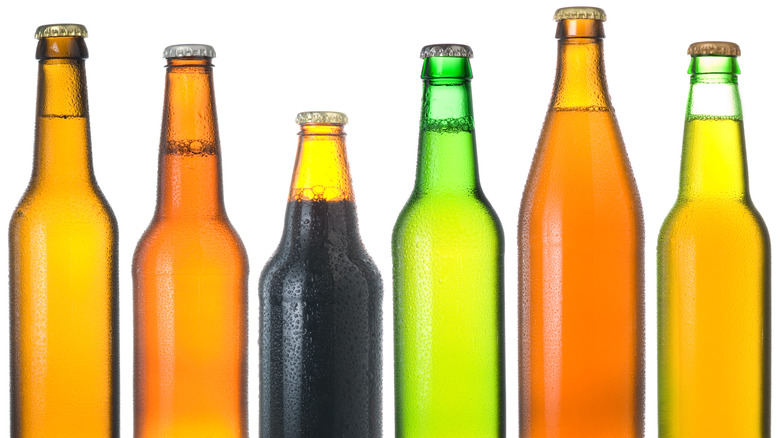When It Comes To Beer, Does The Bottle Color Actually Matter? We Asked A Brewer
When you take that first sip of ice-cold beer out of a glass bottle, what's the first thing you notice? Is it as refreshingly crisp as you'd imagined? Does it have a bit of an odor or tang? Now, take note of the color of the glass. Is it brown? Green? Clear? Turns out, this is all done by design — and we're not just talking about aesthetics for marketing purposes. The impact the bottle's color has on the taste of beer is deeply rooted in science. Jeff Tyler, co-owner and head brewer of Spice Trade Brewery & Kitchen in Greenwood Village, Colorado, sheds some light (pun very much intended) on the significance of bottle color, particularly when it comes to preserving the quality of the malty beverage.
Light, especially in the ultraviolet (UV) spectrum, can initiate chemical reactions in beer that lead to undesirable changes in its flavor and fragrance. Brown bottles have been a traditional choice for beer packaging, and according to Tyler, they remain a practical, reliable option. "Brown bottles are not bad, and if the beer that I'm looking for happens to only be in a brown bottle, it's not going to stop me from buying it," he explains. The primary reason behind this preference lies in brown's ability to restrict a substantial portion of the harmful wavelengths of light. Brown bottles act as a natural barrier against these detrimental effects, providing a level of protection that helps maintain the beer's freshness.
The bottle color may affect the taste and smell of beer
In contrast to brown bottles, green glass poses a more significant threat to beer's integrity. "Green glass does not block out certain wavelengths of light and can lead to beer becoming lightstruck if exposed to sunlight, leading to a signature skunky aroma," Tyler clarifies. This process results in the development of off-flavors, which many beer enthusiasts aim to avoid. However, if you're loyal to Stella Artois, Rolling Rock, Heineken, or any other brand in emerald containers, you likely don't mind the pungence.
The scientific explanation for this optical phenomenon involves the interaction between UV light and the hops used in brewing. Hops, the flowers that contribute to beer's bitterness, contain compounds called isohumulones. When exposed to UV light, isohumulones undergo a reaction that produces the compounds responsible for the unpleasant scent. Brown bottles act as a shield.
Considering the pitfalls of glass, it makes sense that the popularity of canned beer continues to rise. Tyler points out one of the reasons it tastes better than bottled beer. "Cans have a lot of pros," he admits. "They are lightweight, not breakable like glass, easy to recycle (mostly), but most importantly, let in zero light, which keeps beer freshest longest." Aluminum cans have become a preferred choice for some breweries. Unlike bottles, which expose beer to some degree of light, the cans provide an impermeable barrier. This ensures the beer stays in optimal condition until the can is opened.

